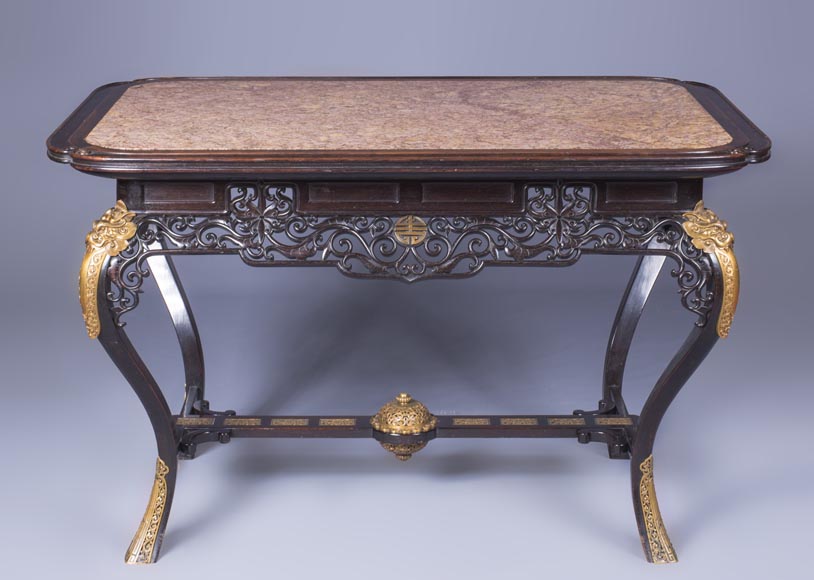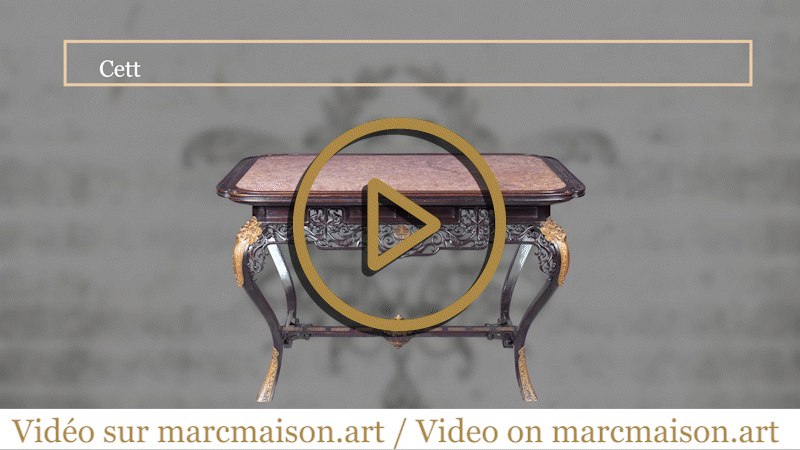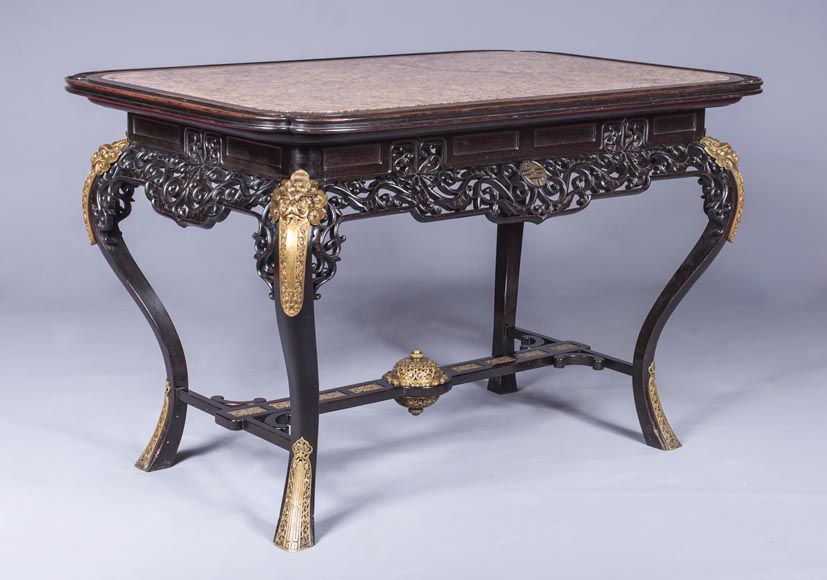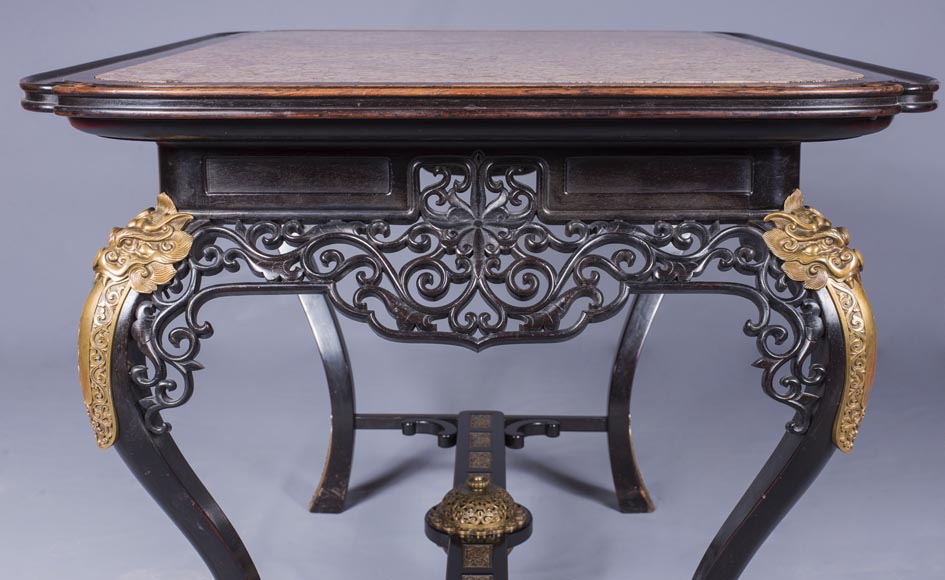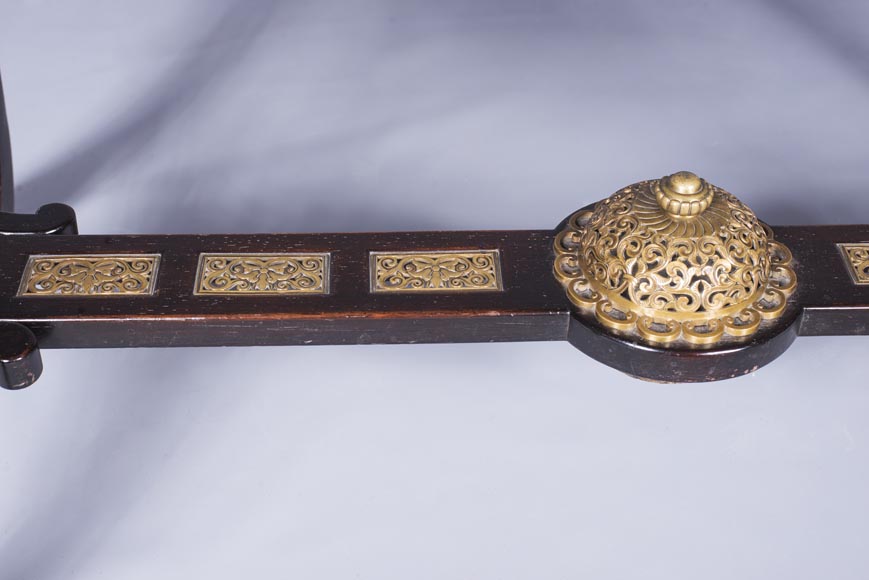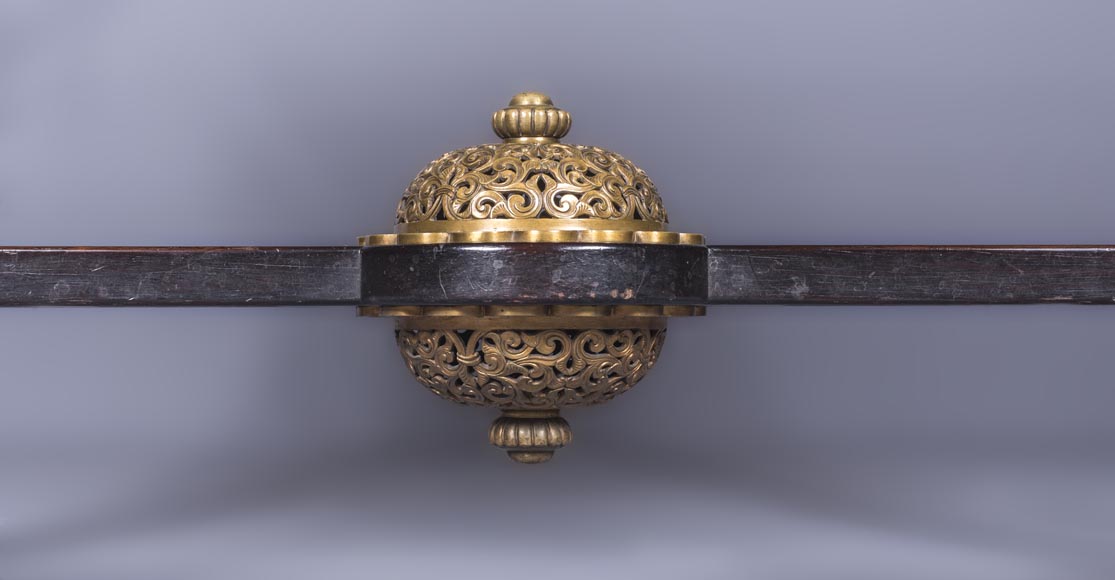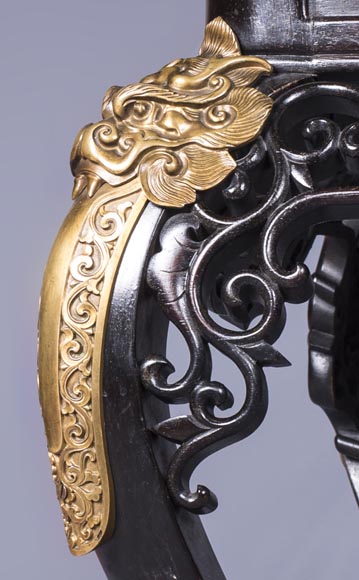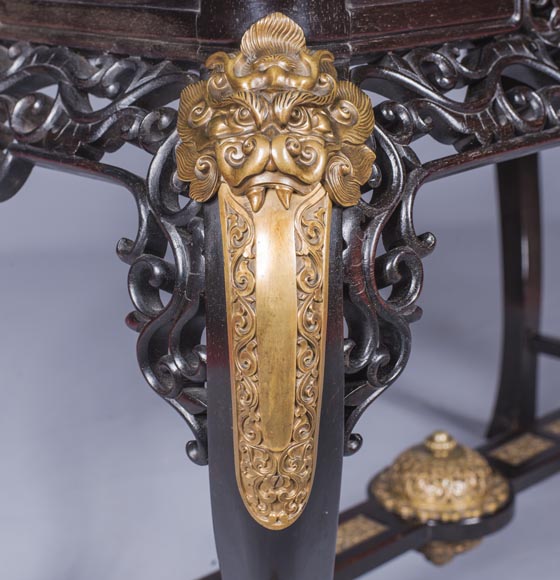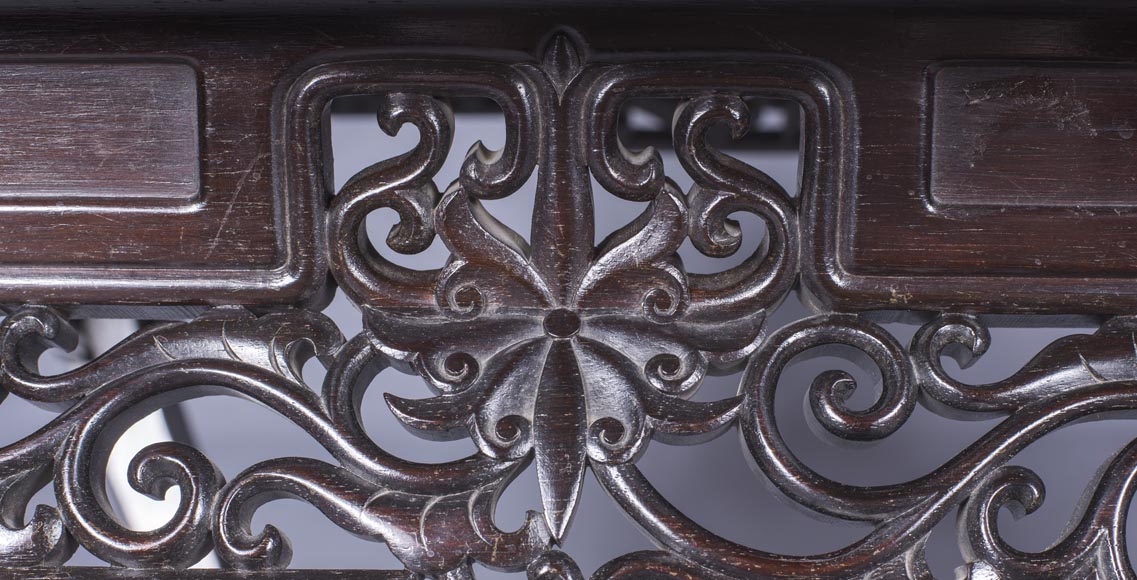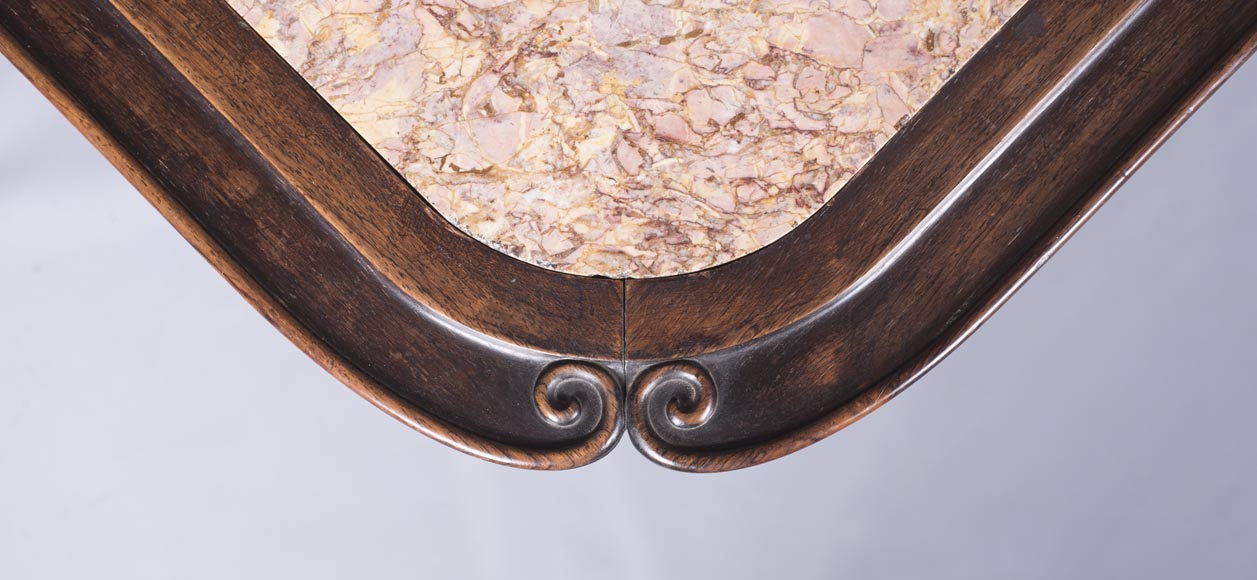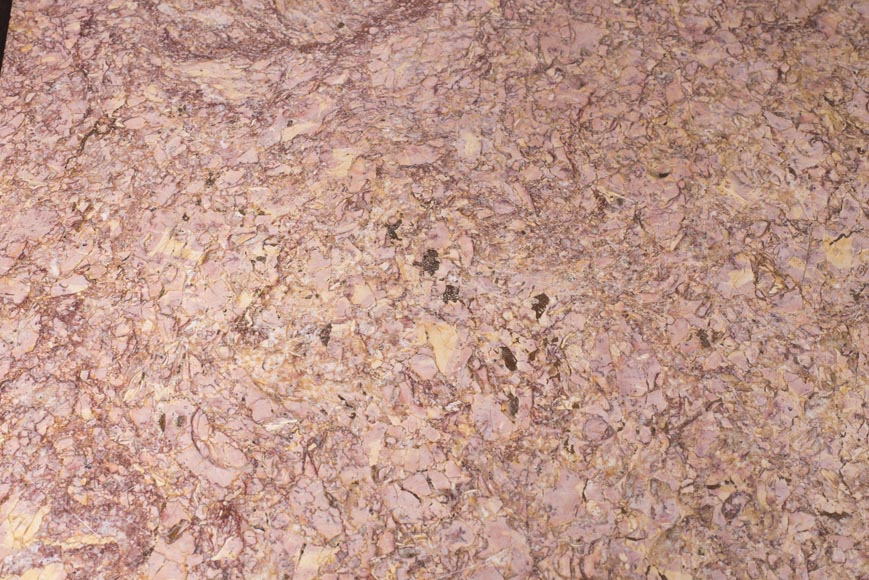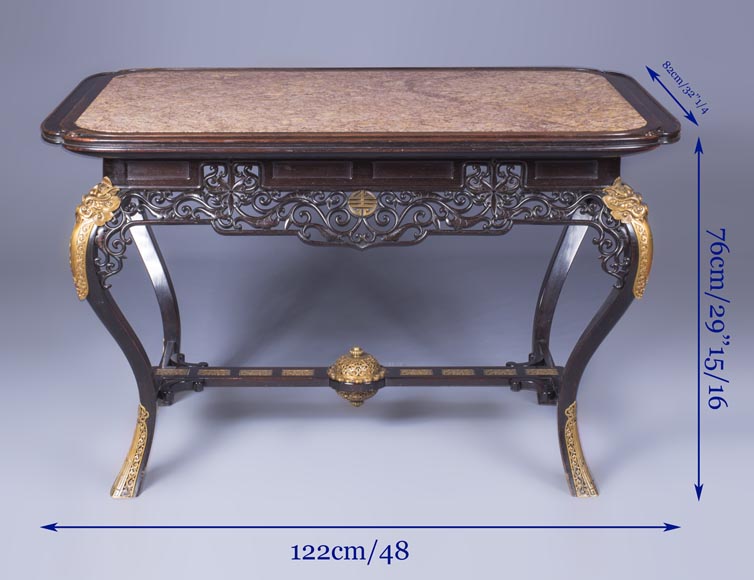Style Japonism, Chinoiserie / Ref.11440
Edouard LIEVRE (1828-1886) - A center table with fantastical masks
Dimensions
Width 48'' 122cm
Height 29'' ⅞ 76cm
Depth: 32'' ¼ 82cm
Origin:
Paris, circa 1878
This center table was designed around 1878 by Édouard Lièvre . Predominant artist of the Japonism in France, Édouard Lièvre experienced two successive professional lives: first as an illustrator, then as an ornamental designer and cabinetmaker, during which time he produced pieces of furniture in a neo-Renaissance style as well as in the Japanese style. Coming from a modest family in eastern France, he began working very early in a lithographic printing house in Nancy before drawing decorative objects for a foundry in the Meuse region. Then he moved to Paris, where he attended the studio of the painter, engraver and lithographer Théodore Valerio. After a trip to Brussels in 1847, he entered the studio of Thomas Couture, academic painter, and he will realize, in watercolor, a copy of the Romans of decadence, noticed by the critic Paul Mantz during the Salon of 1847.
Following the donation to the Louvre Museum of the Charles Sauvageot collection, he was commissioned to publish a selection of works: the two volumes appeared in 1863 under the title "Musée impérial du Louvre : Collection Sauvageot dessinée et gravée à l’eau-forte par Édouard Lièvre". He then began "Les Collections célèbres d’œuvres d’art dessinées et gravées d’après les originaux par Édouard Lièvre", which was published in 1866. In 1870, Alfred Darcel, curator of the Louvre's art objects, wrote the introduction of his new book: "Les Arts décoratifs à toutes les époques". Édouard Lièvre worked for various amateurs as well as for works of art editors for which he drew decorative art models. After his death, the two sales (in 1887 and 1890) during which his possessions were dispersed, were a resounding success thanks to the press.
This beautiful center table perfectly illustrates the artist mastery and his taste for luxurious materials. He chose rosewood for this piece, rare and precious exotic wood, whose dark color enhances the brilliance of gilded bronze ornaments. Warm tones and purple veining bring nobility and character to the furniture. The legs curved shape is counterbalanced by the straightness of the H stretcher and the apron, thus mixing grace and sobriety. The care given to the details is characteristic of Edouard Lièvre's production who seems to "embroider" the wood by producing openworked patterns with extreme precision. Those which adorn the apron of our table are delicately performed. They link the differents parts of the table by inserting the apron through an elegant stylized flower while extending to the curved corners formed by the legs. These openworked decorations are ornated with arabesques, scrolls and stylized plant elements. They are quite representative of the syncretic aspect of Lièvre’s works which mixes different sources of Western and Eastern inspiration. One can observe the same kind of motifs in Gabriel Viardot’s works, another predominant figure of Japonisme in France, who adorns his furniture with a "lace" of carved wood made in the same spirit, despite some formal differences (of which a more geometric aspect).
The apron of our table is adorned with a gilded bronze symbol evoking the shou ideogram, synonymous with longevity. This one is also noticeable on a jardiniere made by Édouard Lièvre for Ferdinand Barbedienne, witness of the vogue for a fantasized Orient and reconstituted through composite elements adapted to Western culture.
The tops of the legs are adorned with fantastic masks which are specific to this table model and of which an identical copy is preserved in the Orsay Museum in Paris. These masks represent a creature that could be a lion or an oriental dragon forming a fall decorated with plant scrolls and covering the curve of the leg. The same ornaments are present on the gilded bronzes feet. Gilded bronze cartouches are inserted at regular intervals on the stretcher. The latter is decorated, in its center, with a gilded bronze grooved ball featuring foliages. All these bronze elements are in their original condition, covered with an old gold patina and not re-gilded.
A beautiful marble slab is insetted in the table top and framed by a moldered rosewood bordure. This "Brocatelle" marble takes its name from a fabric which name comes from the Italian word broccato, technique of fabric manufacture by the "broaching" process. Particularly fragile and difficult to carve, it is still very popular for its decorative value. It is more specifically a "Spanish Brocatelle" because of its extraction site which is in the Pyrenees. The quality and the beautiful tones of this marble (pale pink jasped with yellow, white and gray) contribute to consider this table as a masterpiece.
To date, we know only five tables on the same model and each of them has a different marble top. The one preserved at the Orsay Museum and mentioned above includes a Violet Breccia marble top. The other tables listed (perfectly identical, with the exception of the marble top) are kept in private collections and show other types of marble such as Campan or Sarrancolin. The after death inventory of Édouard Lièvre mentions one of these tables with a marble top made out of Aleppo Breccia
Rosewood, gilded bronze, Brocatelle marble H : 76 cm / 29’’ 15/16 ; L. 122 cm / 48’’ ; P. 82 cm / 32’’ 1/4 Paris, circa 1878
For more information on this work, see the video on MarcMaison.art.
Price: on request
Recommended for you :
Dimensions:
Width: 230
Height: 262
Depth: 66
Dimensions:
Width: 171
Height: 77
Depth: 94
Dimensions:
Width: 186
Height: 212
Depth: 64
Dimensions:
Width: 303
Height: 76
Depth: 115
Dimensions:
Width: 191
Height: 293
Depth: 56
Dimensions:
Width: 72
Height: 76
Depth: 105
Dimensions:
Width: 85
Height: 82
Depth: 57
Dimensions:
Width: 112
Height: 100
Depth: 34
Inner width: 76
Inner height: 81
Dimensions:
Width: 258
Height: 85
Depth: 144



